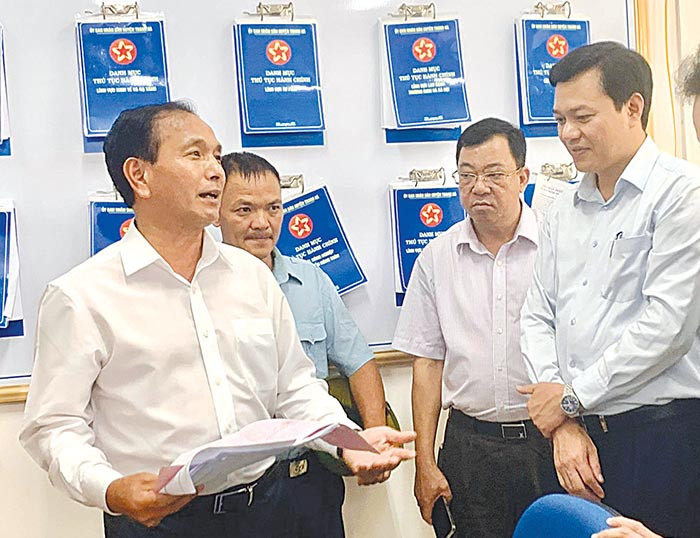The Hai Duong Provincial Land Registration Office (LDRO) was established under Decision No. 1288/QD-UBND dated May 19, 2022 of the Provincial People's Committee on the basis of merging the Provincial Land Use Rights Registration Office and the District Land Use Rights Registration Office.

Provincial leaders presented flowers to congratulate the Hai Duong Provincial Land Registration Office at the ceremony announcing the establishment decision.
The Provincial Land Registration Office has 12 branches in districts, towns and cities and officially came into operation from June 1, 2022.
Hard start
In the first months of operation, the Land Registration Office must maintain stable operations, reorganize its apparatus according to the "one-level" model and gradually advise on the construction, updating, and exploitation of the cadastral database, synchronize cadastral records from the provincial to the district level, and gradually synchronize them to the commune level. This is the basis for building a synchronous land database for the whole province.
With a large amount of work and heavy tasks, in the past, the Provincial Land Registration Office has encountered many difficulties, from organization work, handling administrative procedures (AP), party and union work. Currently, the number of staff of the Provincial Land Registration Office is still small while the workload is large. The previously established cadastral records system is not complete and synchronous, lacking components and information. The cadastral map system was built in many different periods, many different coordinate systems, especially after the survey, it has not been upgraded, leading to many difficulties in handling AP. The organizational structure of some departments and branches has not been fully consolidated, machinery and equipment are still lacking and too old, the working room is cramped. The information technology system has not been connected synchronously, while receiving documents and returning results of AP resolution must digitize the entire file, which takes a lot of time and human resources. Especially with the current requirement to receive documents in an electronic environment while the computer system is old, the installation of software and database systems to connect all levels is very limited, leading to difficulties in solving tasks and slow progress.
In the process of performing professional tasks, the appraisal of dossiers for granting certificates also encountered many difficulties. Many dossiers and certificates previously issued were not unified, were missing or had errors in the origin of land use and information. The implementation methods of each locality were different and not uniform. When the one-level Land Registration Office was established, it was necessary to unify the expertise throughout the province, so it encountered many difficulties in handling previous limitations.
To implement Plan 569/KH-UBND dated March 7, 2022 of the Provincial People's Committee on implementing Decision No. 06/QD-TTg dated January 6, 2022 of the Prime Minister approving the Project "Developing the application of population data, identification and electronic authentication to serve the national digital transformation period 2022-2025, vision to 2030" in the province, the work of building a land database is very necessary, meeting the connection of land data information with the national database. For the land database, information on land users and maps must be unified. However, the previously issued certificates (GCN) (issued according to the paper map of the 1993 period, map 299) compared to the current status and the newly surveyed map are not unified, there are many differences. The work of issuing certificates after surveying the map has not been carried out, and the work of updating changes has not been focused on. Therefore, to ensure the settlement of administrative procedures and updating the cadastral database, it takes a lot of time to re-measure. In addition, in some localities, the work of handling and issuing certificates for cases with increased areas compared to the issued certificates has not been thorough, greatly affecting the synchronous updating of the cadastral database.
In addition, the current electronic one-stop software developed by the Department of Information and Communications is not yet complete and does not meet the actual work being done to control land-related administrative procedures as prescribed. Many administrative procedure settlement records of the Land Registration Office are in the stage of waiting for people to pay taxes but are counted in the time for handling administrative procedures of the Land Registration Office. Therefore, recently, many land records have been reported as overdue on the Provincial Public Service Portal system. While the Provincial Land Registration Office has to focus on overcoming difficulties and ensuring professional tasks, some organizations and individuals with their own purposes have taken advantage of this time to send many petitions and petitions on the land sector.

The Provincial Land Registration Office regularly receives attention from the Provincial Party Committee, People's Council, and Provincial People's Committee.
Initial results
Faced with the above difficulties, with the political determination of the entire system, the Provincial Land Registration Office has overcome many limitations in organization and operating mechanism of the previous Land Use Right Registration Office system. This is the basis and foundation for building a land database, connecting data with other sectors, moving towards building a modern, centralized and unified national land information system.
The Provincial Land Registration Office has advised the Department of Natural Resources and Environment to issue documents to unify a number of measures to overcome obstacles, difficulties, and professional limitations in order to resolve records in accordance with the provisions of law, and bring land management activities into order. The work of adjusting changes after granting certificates has been carried out synchronously. As soon as it came into operation, the Land Registration Office has promptly resolved, accelerated the implementation of administrative procedures, and publicized administrative procedures. The work of updating and adjusting cadastral records, land statistics, and inventories has been focused on, contributing to improving the effectiveness and efficiency of state management of land, serving people and businesses in the process of looking up and providing cadastral information to ensure accuracy and timeliness.
The Land Registration Office regularly advises and proposes solutions to problems in the issuance of certificates of land use rights to organizations, families and individuals. Advises on the issuance of documents on the management, use and correction of cadastral maps, exploitation and updating of land databases. Provides guidance on the implementation of cadastral map extracts and cadastral measurements, and correction of cadastral maps applied within the Land Registration Office system. Coordinates and shares data to serve the implementation of Project 06. The Land Registration Office has cleaned cadastral data for nearly 4,000 files that have completed administrative procedures, digitized nearly 30,000 files after handling administrative procedures. Advises on the development of coordination regulations in the activities of the Land Registration Office with relevant agencies. By November 30, the Provincial Land Registration Office had processed nearly 600 files of organizations and nearly 43,200 files of families and individuals. The Land Registration Office has digitized and signed input data and output products at the "one-stop" department of the District Land Registration Office Branch...
The Land Registration Office always identifies the important political goal of building a legal cadastral database system to create the basis and foundation for building a land database, connecting data with other sectors, and moving towards building a modern, centralized and unified national land information system.
LAN NGUYEN